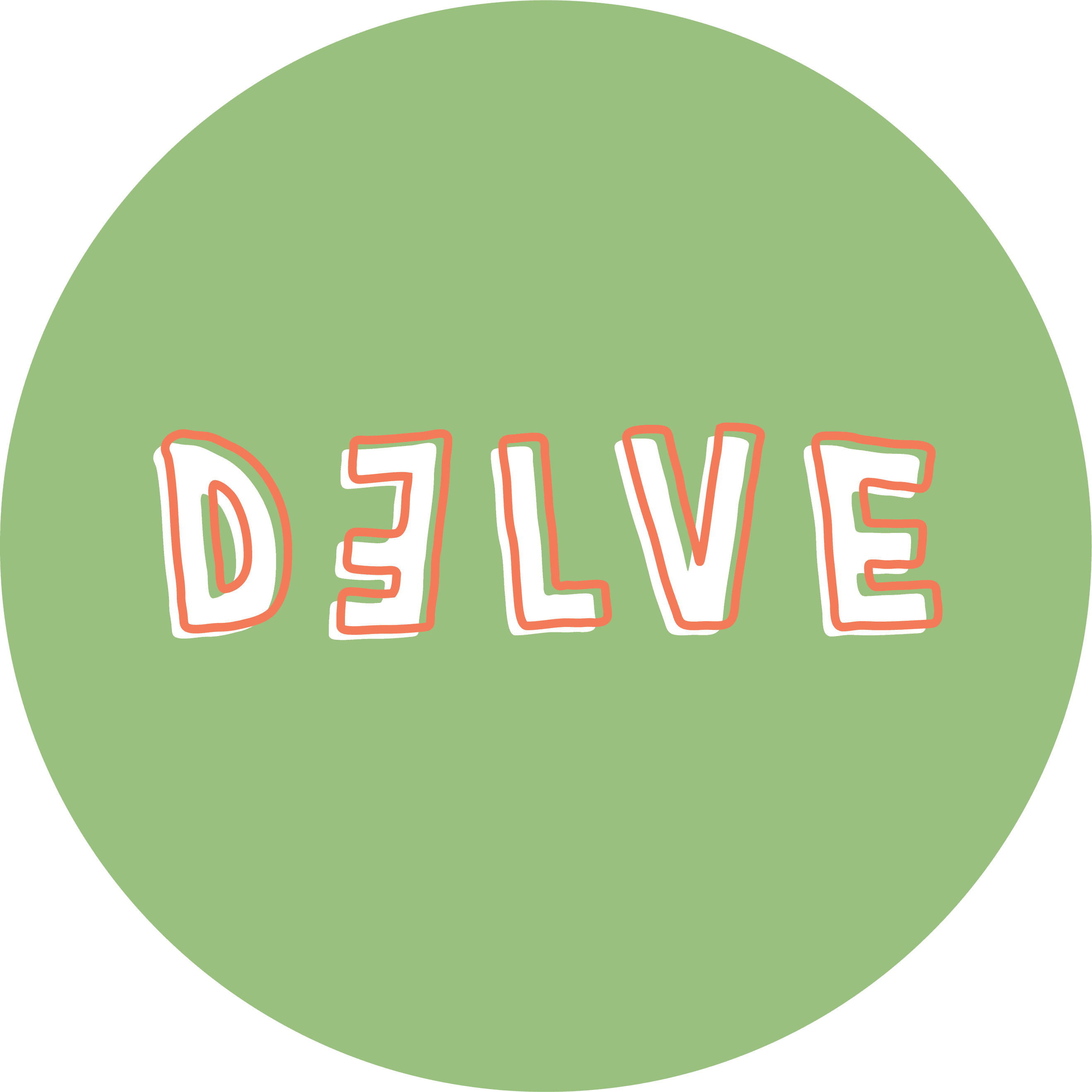UniSC hosted an enlightening Sustainability Week from 28 August–1September 2023, igniting a desire for change amongst students across all campuses. This event allowed students the opportunity to participate in activities and workshops where they could learn about the university’s sustainability initiative and discover ways to become more sustainable in their own lives.
8-Word stories was one of the events run at the Moreton Bay campus giving students the opportunity to creatively express their connection to the cause through thought-provoking stories (that were only eight words long). In appreciation of the students who took their time to engage with the event, we proudly spotlight a select few extraordinary stories that exemplify the essence of sustainability.
The authors of the selected stories have also given us an incredible insight into the meaning behind their stories as well as their personal thoughts on sustainability itself and how it can be improved.
Some of the Delve Magazine designers have also participated by creating artwork that has been inspired by these stories. The impact that words can have is extraordinary and we hope you can be inspired by them too.
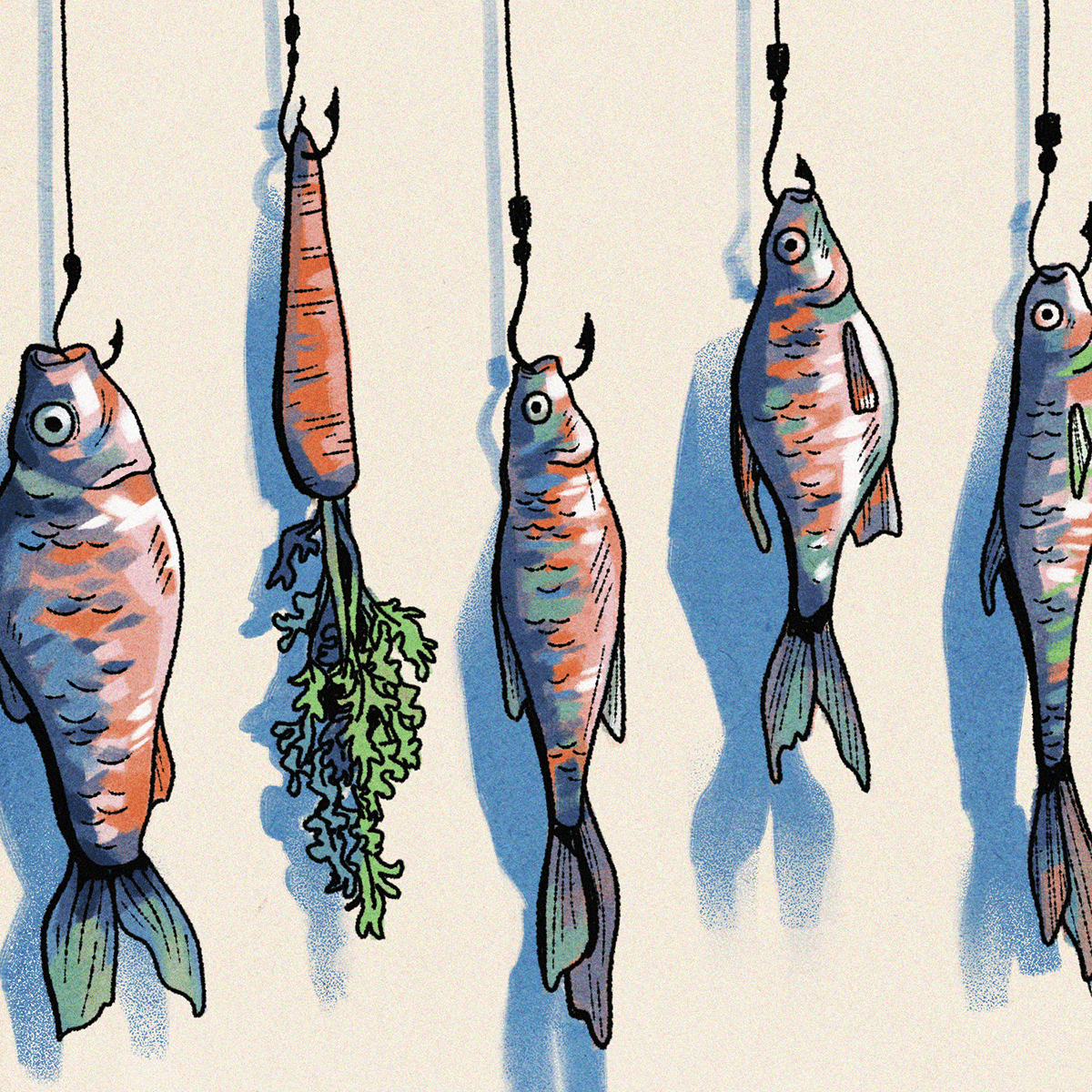


What part of the story inspired your design?
I think the imagery of the fish in the story stuck with me because there’s something quite visceral about how they look. I wanted to make an illustration that focused more so on the imagery and feeling, rather than trying to decipher its meaning.
What is your art style?
I’m inspired by a lot of different things and because of this my ‘style’ changes constantly. This illustration, in particular, was influenced by pop art aesthetics, as well as the general visual identity of the magazine.
Wesley Carlyon
Wesley Carlyon
author insights
author insights
ARTIST INTERPRETATIONS
ARTIST INTERPRETATIONS
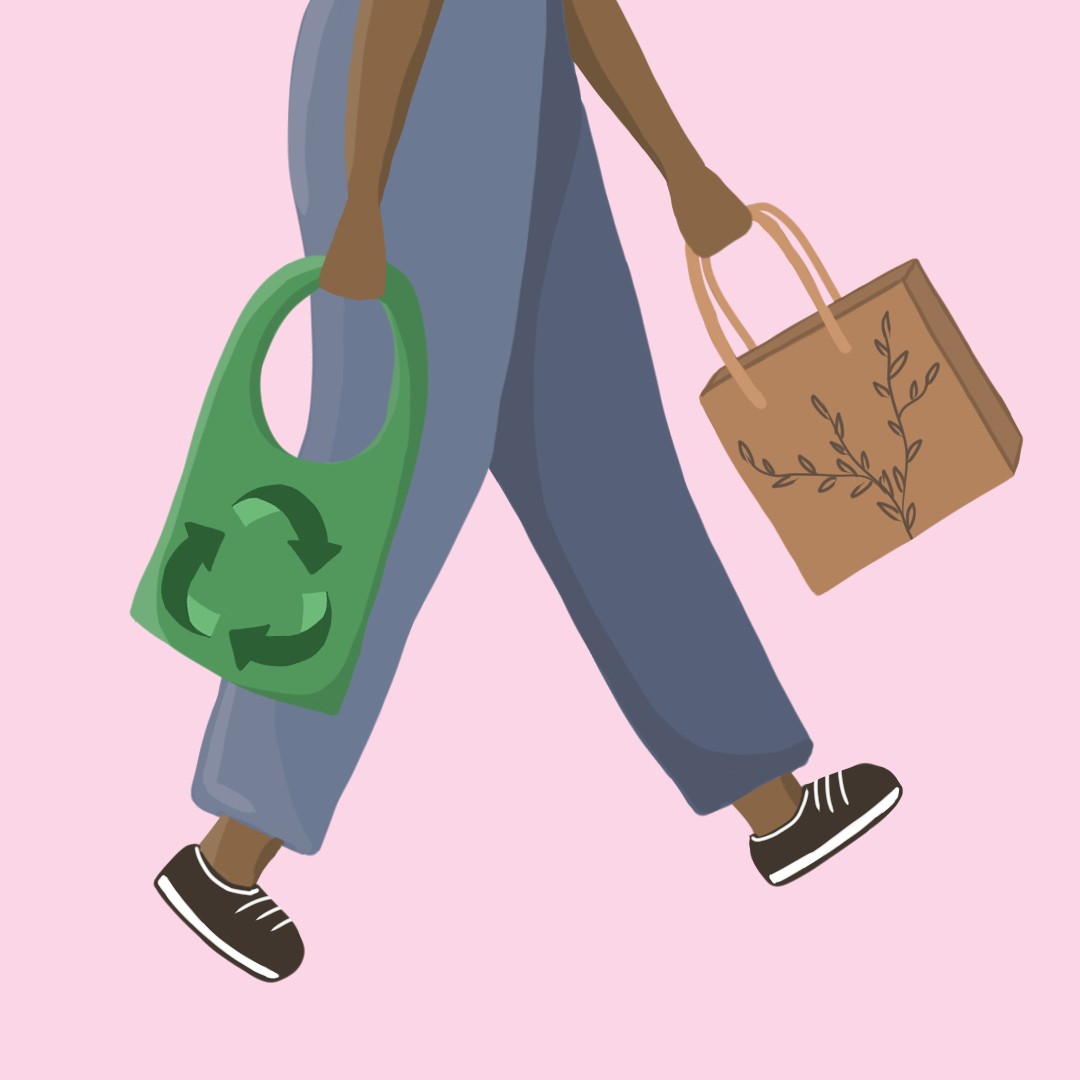
What part of the story inspired your design?
The visual image of being in a shop and realising you’ve left the million bags you have in the back of your car. This is what stood out to me. This then led me to think about all the different types of reusable bags I own. They are all different sizes, shapes and materials. I wanted to represent that in my design.
What is your art style?
I'm inspired by so many different types of art. Art for me is basically therapy, so I’ve tried almost all styles from traditional oil painting, to minimalist digital art which is what I was aiming for with this piece. I don’t think I will ever be able to choose which specific style of art is my own.
TIFFANY REVIE
sustainability week at moreton bay
sustainability week at moreton bay

sustainability week at moreton bay
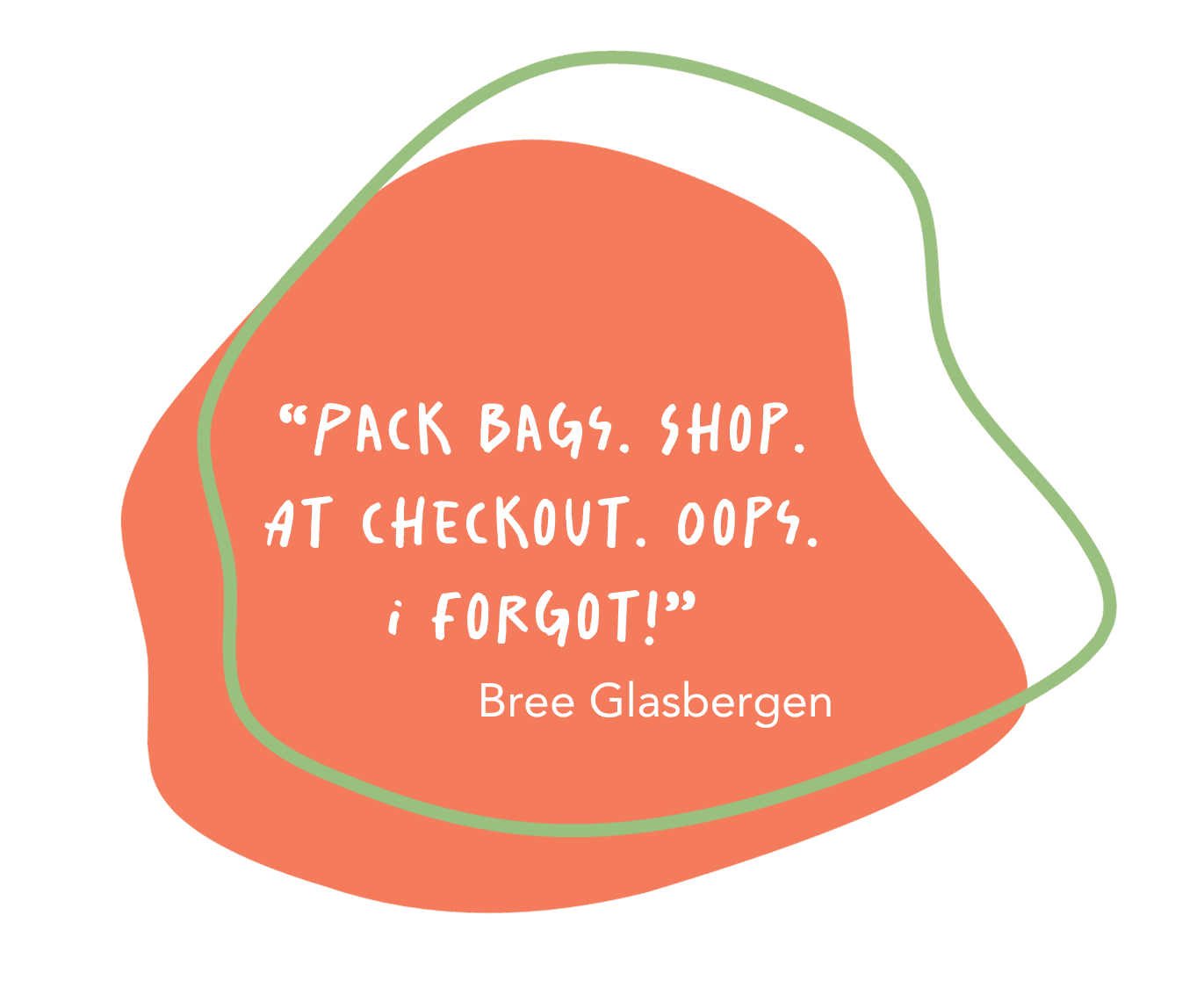



tiffany revie
What was your inspiration behind your story?
The inspiration for this story evolved from the phrase‘ some blessed the chicken and called it fish’, written by 92-year-old Eileen Garvin in her memoir, a second-generation Australian of Celtic immigrants, whose baby cot was a cupboard drawer. This phrase danced off the page as I was editing.
For her, it was a Friday night out with other young mothers during the war years. They had a night of freedom but as Catholics were forbidden meat on Fridays. Balancing the rigid, religious dogma with what was available, they made the night ‘livable’ across all its meanings.
Their path at this time was about making the best of things’, fashioning a sustainable life around poverty, rationing and religious dogma. In other words, you get what you get, and you make it fit. Otherwise, you are swallowed up. This perspective is the essence of my story.
What impact or change would you like to see made towards the goal of sustainability?
Today, we are locked in an anthropocentric dogma that places humans at the centre of and apart from nature. We live by the dogma of more, a craving for bigger, longer, higher, more energy, more products that causes animal suffering.
But as all of us addicts know (convenience, bacon, speed, retail therapy-yep, guilty as charged) any change is awkward and hard.
So, in the meantime, let’s try nurturing the sustainable, bless our 'carrots’, pretending they are fish to ease any craving. The carrots will quickly return our blessings through a new mindfulness of sensitivity and compassion and the fish will eventually slither silently downstream in silvery, cleansing gratitude.
What is the meaning behind the story?
The meaning behind the story is we are all human and bound to make mistakes, but the intention is what matters. It is also meant to be a bit of a light-hearted commentary on my own imperfect sustainability habits.
What inspired your story?
The story was inspired by me packing reusable shopping bags into my car and trying to be responsible. Yet, somehow almost always I end up purchasing new ones because I miss the crucial step of remembering to take the bags into the shopping centre with me. Oops!
What impact or change would you like to see made towards the goal of sustainability?
I would love to see it normalised for advertising printed on leaves or bark. Coffee loyalty cards, flyers etc. Last year our student club Plot Twist wrote kind messages of hope on eucalyptus leaves and handed them out on campus. People kept them as bookmarks or momentos and then returned them to the earth when they began to decompose. Leaves can be cut with hole punches and used as confetti, too. Such a simple and meaningful way to think outside the box on sustainability!

tiffany revie
I find it difficult to answer this question. There’s the obvious answer of designers and artists being conscious of their consumption when creating. Artists can also generate awareness through their work and inspire change through empathy and emotive pieces of art. But how far does ‘generating awareness’ go and at what point is action required that is outside the sphere of creatives? At a certain point, education needs to progress into action and unfortunately there is some action that is out of our hands. Behaving as sustainable as possible in your work can only go so far when there’s a lack of political action, or when big business owners care more about this month’s profit than the world we live in.
How do you think design can help sustainability?
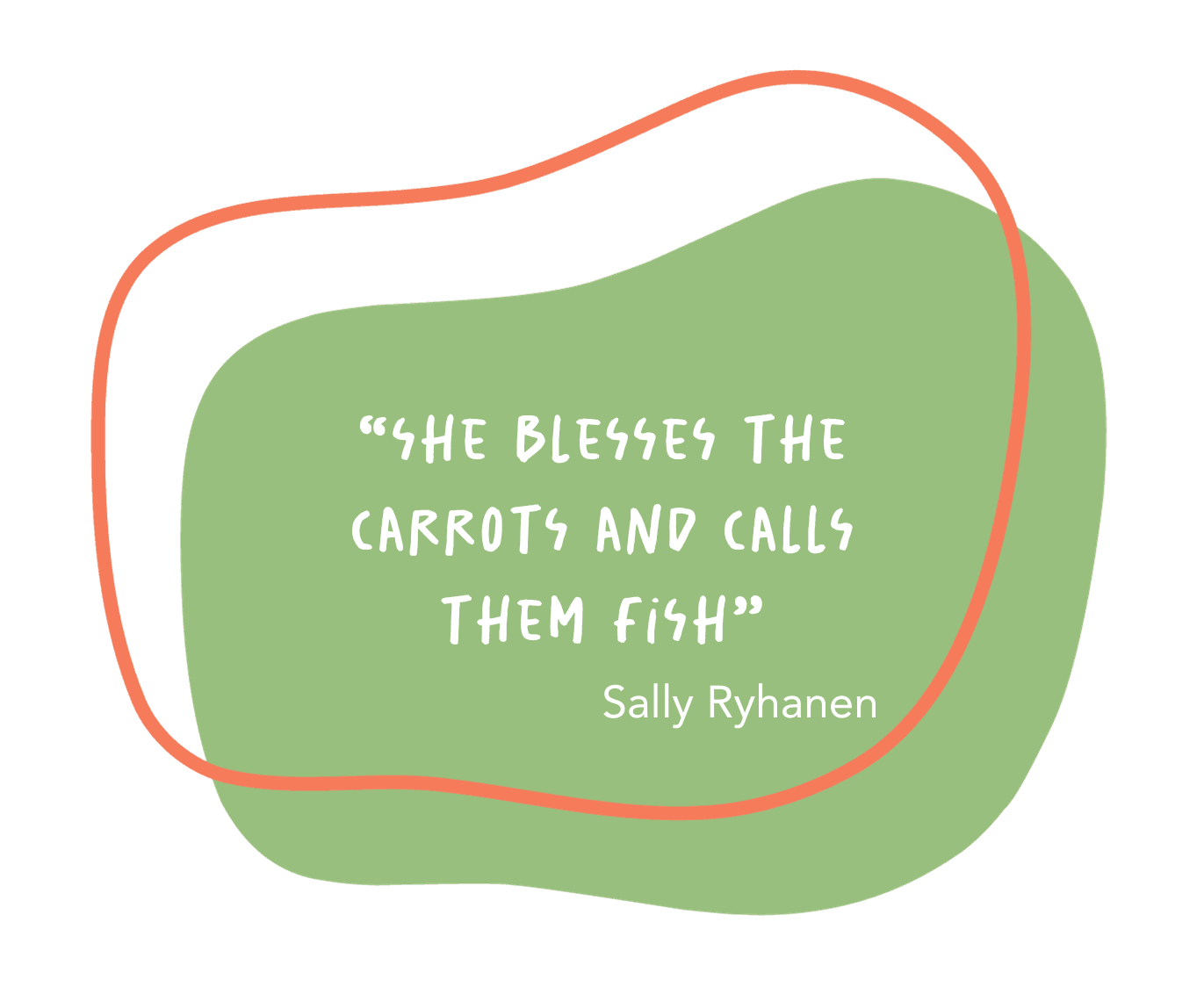
What was your inspiration behind your story?
The inspiration for this story evolved from the phrase‘ some blessed the chicken and called it fish’, written by 92-year-old Eileen Garvin in her memoir, a second-generation Australian of Celtic immigrants, whose baby cot was a cupboard drawer. This phrase danced off the page as I was editing.
For her, it was a Friday night out with other young mothers during the war years. They had a night of freedom but as Catholics were forbidden meat on Fridays. Balancing the rigid, religious dogma with what was available, they made the night ‘livable’ across all its meanings.
Their path at this time was about making the best of things’, fashioning a sustainable life around poverty, rationing and religious dogma. In other words, you get what you get, and you make it fit. Otherwise, you are swallowed up. This perspective is the essence of my story.
What impact or change would you like to see made towards the goal of sustainability?
Today, we are locked in an anthropocentric dogma that places humans at the centre of and apart from nature. We live by the dogma of more, a craving for bigger, longer, higher, more energy, more products that causes animal suffering.
But as all of us addicts know (convenience, bacon, speed, retail therapy-yep, guilty as charged) any change is awkward and hard.
So, in the meantime, let’s try nurturing the sustainable, bless our ‘carrots’, pretending they are fish to ease any craving. The carrots will quickly return our blessings through a new mindfulness of sensitivity and compassion and the fish will eventually slither silently downstream in silvery, cleansing gratitude.

What is the meaning behind the story?
The meaning behind the story is we are all human and bound to make mistakes, but the intention is what matters. It is also meant to be a bit of a light-hearted commentary on my own imperfect sustainability habits.
What inspired your story?
The story was inspired by me packing reusable shopping bags into my car and trying to be responsible. Yet, somehow almost always I end up purchasing new ones because I miss the crucial step of remembering to take the bags into the shopping centre with me. Oops!
What impact or change would you like to see made towards the goal of sustainability?
I would love to see it normalised for advertising printed on leaves or bark. Coffee loyalty cards, flyers etc. Last year our student club Plot Twist wrote kind messages of hope on eucalyptus leaves and handed them out on campus. People kept them as bookmarks or momentos and then returned them to the earth when they began to decompose. Leaves can be cut with hole punches and used as confetti, too. Such a simple and meaningful way to think outside the box on sustainability!
I would love to see it normalised for advertising printed on leaves or bark. Coffee loyalty cards, flyers etc. Last year our student club Plot Twist wrote kind messages of hope on eucalyptus leaves and handed them out on campus. People kept them as bookmarks or momentos and then returned them to the earth when they began to decompose. Leaves can be cut with hole punches and used as confetti, too. Such a simple and meaningful way to think outside the box on sustainability!


What part of the story inspired your design?
I think the imagery of the fish in the story stuck with me because there’s something quite visceral about how they look. I wanted to make an illustration that focused more so on the imagery and feeling, rather than trying to decipher its meaning.
What is your art style?
I’m inspired by a lot of different things and because of this my ‘style’ changes constantly. This illustration, in particular, was influenced by pop art aesthetics, as well as the general visual identity of the magazine.
How do you think design can help sustainability?
I find it difficult to answer this question. There’s the obvious answer of designers and artists being conscious of their consumption when creating. Artists can also generate awareness through their work and inspire change through empathy and emotive pieces of art. But how far does ‘generating awareness’ go and at what point is action required that is outside the sphere of creatives? At a certain point, education needs to progress into action and unfortunately there is some action that is out of our hands. Behaving as sustainable as possible in your work can only go so far when there’s a lack of political action, or when big business owners care more about this month’s profit than the world we live in.
What part of the story inspired your design?
The visual image of being in a shop and realising you’ve left the million bags you have in the back of your car. This is what stood out to me. This then led me to think about all the different types of reusable bags I own. They are all different sizes, shapes and materials. I wanted to represent that in my design.
What is your art style?
I'm inspired by so many different types of art. Art for me is basically therapy, so I’ve tried almost all styles from traditional oil painting, to minimalist digital art which is what I was aiming for with this piece.I don’t think I will ever be able to choose which specific style of art is my own.
How do you think design can help sustainability?
My ultimate goal is to become a design and art teacher in regional Queensland. By incorporating eco-friendly practices, such as promoting sustainable design principles, into education, art and design can contribute to environmental sustainability in such a vast way. It can also inspire the next generation to come up with creative solutions to the environmental problems we face today. All of this makes design and art such an imperative tool for the future.
What part of the story inspired your design?
I think the imagery of the fish in the story stuck with me because there’s something quite visceral about how they look. I wanted to make an illustration that focused more so on the imagery and feeling, rather than trying to decipher its meaning.
What is your art style?
I’m inspired by a lot of different things and because of this my ‘style’ changes constantly. This illustration, in particular, was influenced by pop art aesthetics, as well as the general visual identity of the magazine.
How do you think design can help sustainability?
I find it difficult to answer this question. There’s the obvious answer of designers and artists being conscious of their consumption when creating. Artists can also generate awareness through their work and inspire change through empathy and emotive pieces of art. But how far does ‘generating awareness’ go and at what point is action required that is outside the sphere of creatives? At a certain point, education needs to progress into action and unfortunately there is some action that is out of our hands. Behaving as sustainable as possible in your work can only go so far when there’s a lack of political action, or when big business owners care more about this month’s profit than the world we live in.
What part of the story inspired your design?
The visual image of being in a shop and realising you’ve left the million bags you have in the back of your car. This is what stood out to me. This then led me to think about all the different types of reusable bags I own. They are all different sizes, shapes and materials. I wanted to represent that in my design.
What is your art style?
I'm inspired by so many different types of art. Art for me is basically therapy, so I’ve tried almost all styles from traditional oil painting, to minimalist digital art which is what I was aiming for with this piece. I don’t think I will ever be able to choose which specific style of art is my own.
How do you think design can help sustainability?
My ultimate goal is to become a design and art teacher in regional Queensland. By incorporating eco-friendly practices, such as promoting sustainable design principles, into education, art and design can contribute to environmental sustainability in such a vast way. It can also inspire the next generation to come up with creative solutions to the environmental problems we face today. All of this makes design and art such an imperative tool for the future.
My ultimate goal is to become a design and art teacher in regional Queensland. By incorporating eco-friendly practices, such as promoting sustainable design principles, into education, art and design can contribute to environmental sustainability in such a vast way. It can also inspire the next generation to come up with creative solutions to the environmental problems we face today. All of this makes design and art such an imperative tool for the future.
How do you think design can help sustainability?
13.10.23
written by
tiffany revie

13.10.23
written by
tiffany revie

